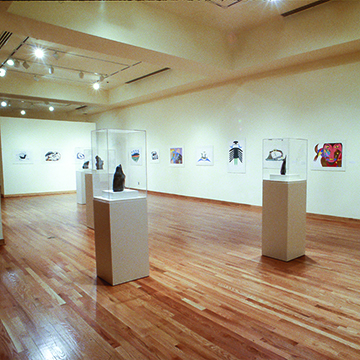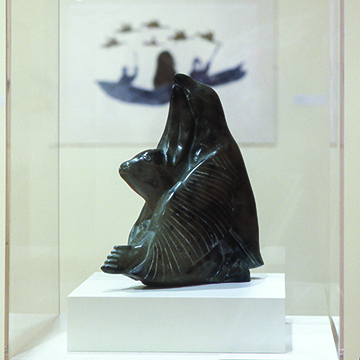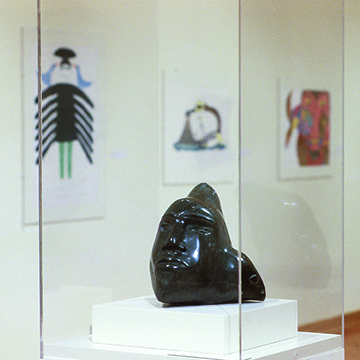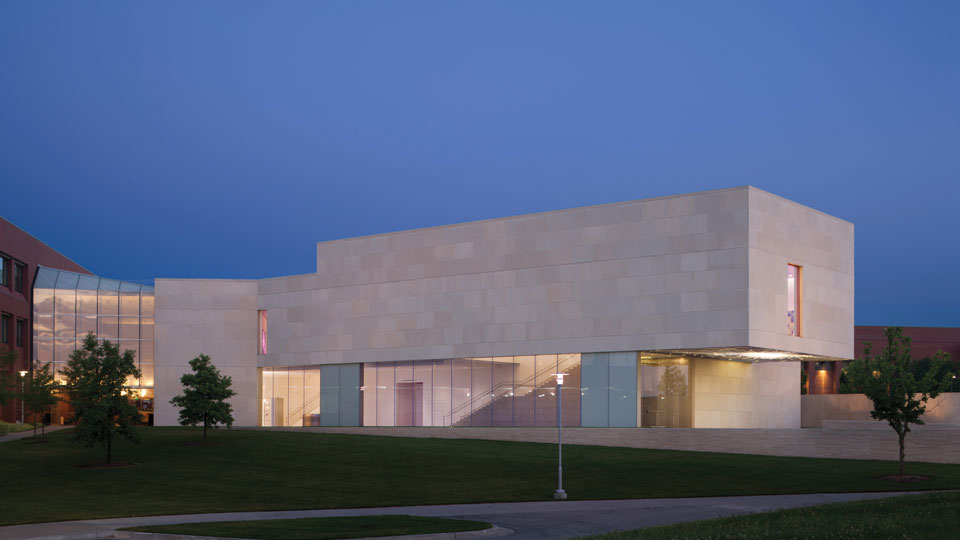Contemporary Inuit Art
For more than 4,000 years, Eskimos (who prefer to be called Inuit – “the people”) tracked seals and caribou across the ice-bound coast of the Arctic Ocean and faced harsh ocean voyages in search of whales. The cold hard life of these nomadic hunters was reflected in their art – carved figures of animals to assure successful hunts, amulets to ward off evil spirits, and ceremonial masks to call upon good spirits. An exhibition of Inuit work with 40 prints and eight sculptures selected from a private collection will be on display at the JCCC Gallery of Art. These colorful and highly stylized works record the mythology and daily routine of the Inuit.
Cut off from civilization by a climate too harsh for trees to grow, the Inuit were not discovered by the art world until 1948 when Canadian artist James Houston began sketching and painting along the east coast of the Hudson Bay. During that summer Houston encountered Inuit artists and was astounded by the strength and integrity of their small carvings. Houston returned to the Arctic Circle the following summer and stayed 12 years, encouraging the local artists and trying to develop markets for their work. At first the Inuit craftsmen produced primarily small carvings of animals and human figures in indigenous materials such as ivory, bone and soapstone. The artists had high standards. Houston said, “They judge a good carving by the sense of life the carver finds hidden in the stone. A carving should reveal the weight of a walrus, the agility of a bear, the sleekness of a fish, the closeness of a mother and child.” Later, Houston’s wife persuaded Inuit women to market garments they had sewn from the furs of Arctic animals – brightly decorated clothing that enabled the Inuit to survive on the frozen tundra.
By the late 1950s Houston’s protégés were open to a new challenge – drawing and printmaking as a means of gaining economic independence. The Inuit artists smoothed the surfaces of soapstone for relief printmaking and prepared dried sealskins for templates for stencil printing, an outgrowth of women’s traditional applique work on clothing. The prints are a visual history of the experiences and imagination of the last generation of Inuit to live as their ancestors did – as fishermen and hunters following the migration of animals.
A small portfolio of Inuit prints was well received in exhibitions in Winnipeg and Stratford, Ontario, in 1958 and 1959, and was to become the first annual print collection issued by a consortium of Inuit printmakers, Cape Dorset’s West Baffin Eskimo Cooperative. Critics admired the originality, directness and vitality of the collection, while collectors and museums began making large-scale purchases and organizing exhibitions.
In cooperation with the Smithsonian Institution, an exhibition of Inuit art toured the United States. It was one of several programs sponsored by the Canadian government beginning in 1950. Exhibition visitors were encouraged to purchase pieces from the collection.
Local collector Dr. Pricilla Tyler (professor emeritus of education and English, University of Missouri, Kansas City) was introduced to the art of the Inuit by happenstance. She was outfitting a cottage on the Bruce Peninsula of Lake Huron when she came across some carvings by local Inuit artists. “I bought my first carvings of a seal, a bear and two highly stylized birds in 1957 in Ontario, Canada,” Tyler said. But Tyler did not become a collector until 1970 when she and a friend, Maree Brooks, followed the ancient migration route of the Inuit eastward from Alaska to Greenland.
Today, the Inuit live near and work at US and Canadian military bases built during the Cold War. By the early 1970s they were relocating from their traditional homes to permanent settlements where federal schools and health care facilities have been established. They have come face to face with high technology and cultural forces very different from their prior experiences. Their historic way of life has virtually disappeared, although elements are represented visually, recreated and captured in art.
A lecture by Inuit art expert Marion Jackson, Ph.D., associate dean, school of art, University of Michigan, will be held at 3 p.m. Saturday, June 8, in conjunction with the opening of the exhibition.





